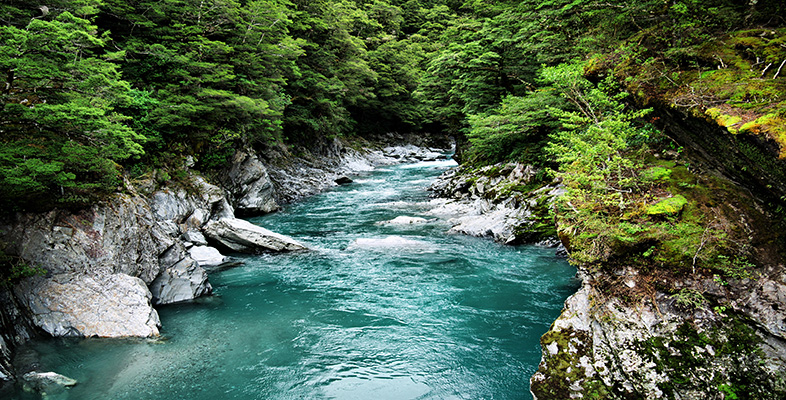2.6.2 (b) Using spheres
Chemists have their own convention for representing molecules and their constituent atoms. As in Figure 6, they often use circles (or spheres if they make a three-dimensional model) to represent atoms - and they often use short, straight lines between the circles to represent the bonds that join one atom to another in molecules such as water. For now, think of these bonds as a sort of 'glue' that holds the atoms together (much like the studs on Lego). Thus a chemist's drawing of water might look something like Figure 8a. Chemists sometimes make models using specially designed 'ball-and-stick' kits - an example is shown in Figure 8b. This enables the relative positions of the centres of the atoms to be seen more easily; water is a bent molecule with an angle of about 104° between the two hydrogen-oxygen bonds in each molecule. Figure 8c is a computer-drawn space-filling view. A note on colour: chemists traditionally use white spheres for hydrogen atoms and red ones for oxygen atoms. Later in this course you will see that black spheres are used for carbon atoms and blue ones for nitrogen atoms.
Models can be very helpful in showing how atoms fit together to make molecules.

With Lego, an enormous range of structures can be built from a small number of different types of block. It is just the same for atoms: there are only about 100 different types of atom in the entire Universe! Yet everything is built from these atoms.
A substance containing only one type of atom is known as a chemical element, or just an element.
Question 5
Given that there are about 100 different kinds of atom in the Universe, how many different elements are there?
Answer
The same number as for the kinds of atoms - about 100.
The Ancient Greeks believed that there were four earthly elements - earth, air, fire and water. However, by the 18th century, the idea that these were fundamental substances was discredited. The scientist John Dalton was the first to propose (in 1808) that elements were composed of atoms, and that substances that were not elements were compounds, comprising a combination of atoms. (Compounds are considered in detail in Section 3.)
Examples of elements that you might have heard of include hydrogen, which has its own unique hydrogen atoms, oxygen which has its own unique oxygen atoms and, an example of an element that you can see, gold which has its own unique gold atoms. A piece of pure gold contains nothing but identical atoms of the element gold.
Question 6
Why is water not classified as a chemical element?
Answer
Water contains the elements hydrogen and oxygen combined together.
Table 2 lists the ten most common elements in the human body which together make up 99.8% of the total number of atoms present in the body. One important kind of atom in living systems, the third one down in Table 2, is the element carbon. It is possible to have some of the element itself - that is, some pure carbon containing nothing but carbon atoms - for example, a piece of charcoal of the type used in barbecues.
| Element | % |
|---|---|
| hydrogen | 63.00 |
| oxygen | 25.20 |
| carbon | 9.50 |
| nitrogen | 1.40 |
| calcium | 0.31 |
| phosphorus | 0.22 |
| potassium | 0.06 |
| sulfur | 0.05 |
| chlorine | 0.03 |
| sodium | 0.03 |
| all others | 0.20 |
